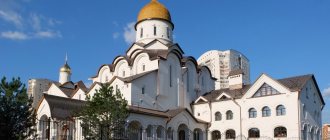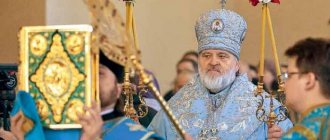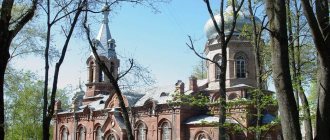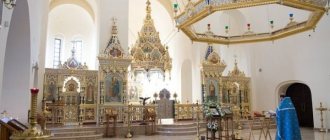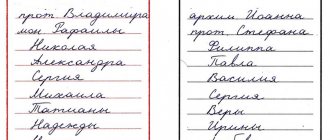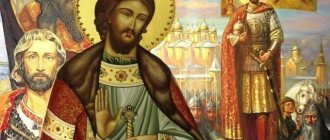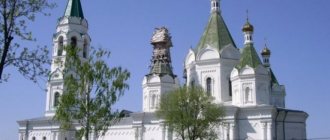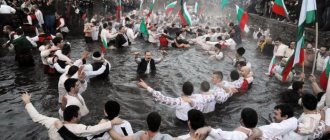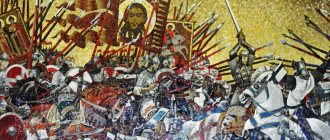| Orthodox church | |
| Church of the Holy Blessed Prince Alexander Nevsky | |
| 47°24′28″ n. w. 40°06′10″ E. d.HGЯOL | |
| A country | Russia |
| City | Novocherkassk |
| Confession | Orthodoxy |
| Diocese | Rostov and Novocherkassk diocese of the Russian Orthodox Church |
| Architectural style | Neo-Byzantine |
| Author of the project | Nikolay Anokhin |
| Construction | 1891-1896 |
| Status | OKN No. 6100113000 No. 6100113000 |
| State | current |
| Media files on Wikimedia Commons | |
This term has other meanings, see Church of St. Alexander Nevsky.
Church of the Holy Blessed Prince Alexander Nevsky
- parish church of the Rostov and Novocherkassk diocese of the Russian Orthodox Church in the city of Novocherkassk.
Temple address: Rostov region, Novocherkassk, Aleksandrovskaya street, 78A.
History[ | ]
In 1805, after the foundation of the Ascension Cathedral, Bishop Arseny of Voronezh and Cherkassy consecrated the site for the new Alexander Nevsky Church. Over time, after changing the site for the construction of the temple, the site was consecrated a second time by priest Vasily Rubashkin. Initially, the church was built in wood according to the design of the architect Lavopierre. On June 29, 1810, Archpriest Alexey Oridovsky consecrated the built wooden church in honor of the Holy Prince Alexander Nevsky.
In 1822, a chapel was added to the church in the name of St. Great Martyr Paraskeva Pyatnitsa, consecrated on October 26 of the same year by Archpriest Jacob Merkhalev. In 1827, military ataman D.E. Kuteynikov proposed to build a stone church in Novocherkassk instead of the wooden stone Alexander Nevsky Church. D. E. Kuteynikov's proposal was supported, a plan with an estimate was drawn up, approved in 1829 by Emperor Nicholas 1 with the order to begin construction of the stone Alexander Nevsky Church after the completion of the construction of the stone Military Ascension Cathedral in Novocherkassk.
In 1834, a new bell tower was built, in 1835 the church itself was rebuilt, a stone foundation was laid and a second side altar was built. In 1866, the wooden roof on the Alexander Nevsky Church was replaced with an iron one.
The construction of the stone church was delayed. In 1889, a new project for a stone church was drawn up, modeled on the church on the estate of F. Ya. Tereshchenko near Kyiv. The project was approved by the Military Ataman, Prince N.I. Svyatopolk-Mirsky, and Archbishop Macarius gave his blessing for the implementation of the project.
Work on the construction of the new temple began in 1891. In 1893, the construction of the church was roughly completed. In the summer of 1894, a cross was installed on the main dome of the temple.
Church warden A. Abramov ordered a marble iconostasis from his own funds in Moscow to master Kutyrin for 22 thousand rubles. In the summer of 1896, the iconostasis was received and installed. The right aisle of the church was built in honor of St. Great Martyr Paraskeva, named Friday and consecrated on October 19, 1897 with the blessing of Archbishop Athanasius. In 1899, the temple was painted inside with oil paint and covered with wall paintings by the painter Gordienko.
The new Alexander Nevsky Church was built in the neo-Byzantine style, with a semicircle in the altar, behind which there was a room for the sacristy. The temple could accommodate up to 1500 people.
The following were assigned to the Alexander Nevsky Church:
- Stone Alexander Nevsky Chapel (1882), not preserved.
- Church in the Don Artillery camp (1897).
- A chapel built opposite the building of the Novocherkassk post office (now the Communications Center on Platovsky Prospect).
After the end of the civil war on the Don, the Alexander Nevsky Church was closed. During the Great Patriotic War, the temple was opened, but closed again in 1960.
In the mid-70s, “restoration” began in the church building to create a planetarium. In the 1990s, services began again in the church. On March 12, 1995, new bells were installed.
St. Alexander Nevsky Church in Novocherkassk
St. Alexander Nevsky Church in Novocherkassk is located at the address: Rostov region, Novocherskask, st. Alexandrovskaya, 78A:
Now I’m looking through photographs of churches that I took in Novocherkassk in the summer of 2021 (it’s clear that I remember it with warmth in my soul), but I’m very surprised why I didn’t go inside, because it was working at that time...
And if I intended to get inside the Patriarchal Ascension Military All-Cossack Cathedral, but it turned out to be closed, then the Alexander Nevsky Church was open, but I did not enter it. Strange…
I don’t know, maybe this is connected with my attitude towards Orthodox churches, which is the object being described. I feel some kind of stupor in front of them, perhaps, due to their religious canons. You are not allowed to wear trousers, you are not allowed to wear a hat, you are not allowed to take photographs. An Orthodox church with its unspoken laws cannot serve as a starting point towards the acceptance of faith for a wavering soul. You can enter it either in a state of ecstatic delight, or in a state of resigned submission to fate, but with a clear conviction in the existence of the Almighty. There is no other option. Unlike Lutheran churches, where you can simply enter to experience an atmosphere that is different from secular life. Well, this is like a small lyrical digression. Let's get back to the facts.
Temples of Novocherkassk
The history of Novocherkassk is closely connected with the Russian Orthodox Church and its religious buildings. The city project, developed by Lieutenant General F. P. Devolan, provided for the creation of six city squares with Orthodox churches.
On May 18, 1805, on the church holiday of the Ascension of the Lord, the city of Novocherkassk itself was founded and the first wooden chapel-temple was consecrated, from which the history of the Ascension Cathedral and spiritual life in the new capital of the Don Cossacks began. On the same day, the site for the Alexander Nevsky Church was consecrated. By 1814, all six of the temples planned by Devolan had been built, initially wooden.[1]
On April 5, 1829, an independent second-class Don diocese was established on the Don with the seat of the Don bishops in the city of Novocherkassk, as a result of which the city received diocesan status. Therefore, next to the wooden Ascension Cathedral, the Archbishop's House was built (now the building of the House of Officers), and behind it - the building of the Don Ecclesiastical Consistory with a diocesan warehouse.[1] In the same 1829, the first stone church was built in the city on Nikolskaya Square (now Levski Square) - Nikolaevskaya (also called Nikolskaya or St. Nicholas the Wonderworker, not preserved). It is interesting that in Novocherkassk, 300 meters from each other, there were two St. Nicholas churches: one is Orthodox, indicated above, the other is Old Believers near the Alexander Garden.[1]
Also in Novocherkassk, before the October Revolution, 17 house churches and more than 10 Orthodox chapels were built, most of which have not survived to this day.
House churches:
[2]
- Simeon's Church at the Ataman Palace.
- Cross Church at the Bishop's House. In 1829, an independent second-class Donskaya diocese was opened in Novocherkassk. The city became a diocesan city with the location of the Don Bishop, for whom in 1830 a wooden house on a stone foundation was purchased from Archpriest Merkhalev. In the same year, a wooden cross church in the name of the Kazan Icon of the Mother of God was added to it. After the construction of a brick two-story Bishop's House on Cathedral Square (it was completed in 1834, according to other sources in 1837), in its building on the second floor a cross church was built and consecrated in the name of the Kazan Icon of the Mother of God with a chapel on the right side in the Name of the Transfiguration The Lord's. These house churches were consecrated by Archbishop Afanasy of Novocherkassk and Georgievsk.
- Church In the Name of All Saints at the Donskoy Bishop's Country House. On September 8, 1874, the Church of All Saints, built at the Donskoy bishop's country house (dacha), was consecrated. In the late 1860s, I.M. Platov, the son of the Don Ataman Matvey Ivanovich Platov, donated this territory to the new Archbishop of Don and Novocherkassk Platon. Here the archbishop decided to create a place for people who dedicated their lives to the glory of God, and for this purpose, a temple in the name of all saints was built on the territory of the dacha. It was made of stone, two-story, had a small bell tower and was considered a house church.
- Cyril and Methodius Church at the Novocherkassk men's gymnasium. In 1876, the Novocherkassk Men's Gymnasium received at its disposal a two-story building on Ermakovsky Prospekt, where, along with classrooms and offices, there was room for the house (gymnasium) church. However, the law teacher of the gymnasium, Archpriest Joachim Fesenkov, did not like the premises of the church, which, in his opinion, did not meet the canonical requirements of the Russian Orthodox Church. He was supported by Archbishop of Don and Novocherkassk Platon. Then, on the instructions of the Military Ataman N.A. Krasnokutsky, the Don architect Fomin was instructed to redesign the church premises. Work on the construction of the premises began in the summer of 1882, and on December 12 of the same year, the solemn consecration of the gymnasium church in the name of the holy first teachers Cyril and Methodius took place, already carried out by Archbishop of Don and Novocherkassk Macarius. In 1913, the gymnasium received the name “Novocherkassk named after Ataman Count M.I. Platov gymnasium. During Soviet times, it became secondary school No. 3, which still exists today. A decision was made to restore the house church here.[3]
- Church In the Name of John the Theologian at the Don Theological Seminary. On October 1, 1868, the Don Theological Seminary was opened in Novocherkassk in a rented private house, which in 1883 received a two-story brick building on Platovsky Prospekt, built according to the design of the architect A. A. Yashchenko. In the same year, the seminary church in the name of John the Theologian was consecrated on the second floor of the seminary.
- Nicholas Church in the Donskoy Alexander III Cadet Corps. On February 15, 1883, the Don Cadet Corps was established in Novocherkassk, named after Alexander III. On August 30 of the same year, the grand opening of the cadet corps took place in the premises of private rented houses. On May 6, 1885, the foundation stone for a complex of its own buildings took place, and in August 1886, the main three-story building of the cadet corps was completed. In the same year, under Archpriest Lyaborinsky, the corps church in the name of St. Nicholas, built according to the design of the Moscow architect A. S. Kaminsky, was consecrated. The house church served the cadets until 1920, when, with the establishment of Soviet power on the Don, a military hospital was set up in the building of the cadet corps, and then various military-economic courses were held here. Later, cavalry advanced training courses for command personnel were transferred here, and then the building was occupied by a tank unit.
- Church In the Name of the Great Martyr Barbara in the Mariinsky Women's Gymnasium. In August 1860, a first-class girls' school was opened in a private house, and in August 1867, the Mariinsk Don Women's Gymnasium was created on its basis. In 1883, the gymnasium received at its disposal a three-story stone building on Atamanskaya Street, built according to the design of the architect A. A. Yashchenko. In it, on the second floor, a house church in the name of the Holy Great Martyr Barbara was built and consecrated in 1889. In Soviet times, a cinema and concert hall was organized here for educational institutions that were located in this building - the Pedagogical Institute, the Higher Communist Agricultural School, the Agricultural Technical School, and the Oktyabrsky State Farm Technical School.
- Church of St. Mary Magdalene in the Donskoy Mariinsky Institute for Noble Maidens. In 1891, the Don Mariinsky Institute for Noble Maidens, which had existed in Novocherkassk since 1853, received a three-story stone building on Pochtovaya Street (now Pushkinskaya). On its third floor, above the main entrance, the institute's church in the name of St. Mary Magdalene was built, which was consecrated in the same year, 1891. During Soviet times, from 1920, the church was closed and a military hospital was built in its place, as the Civil War was going on. Later, the Don Institute of Agriculture and Land Reclamation was located here, it was replaced by the Novocherkassk Engineering and Land Reclamation Institute, which after the collapse of the USSR was reorganized into the Novocherkassk State Land Reclamation Academy. The former house church currently houses a spacious classroom for diploma design.
- Church of the Great Martyr John the Warrior at the city prison castle. The history of the Novocherkassk prison castle (not to be confused with the current Novocherkassk prison) began immediately with the founding of the city. In 1813, in a wooden prison located at the beginning of what is now Kavkazskaya Street, right next to the railway track, the prison church in the name of the Great Martyr John the Warrior was consecrated. And in 1891, next to the prison castle, a stone church was built and consecrated in the name of the Great Martyr John the Warrior. During Soviet times, the church and the prison were liquidated. Currently, on the territory of the former prison castle there is an industrial site of the plant named after. Nikolsky.
- Church of the Most Pure Mother of God in the Diocesan Women's School. In 1889, the Diocesan Women's School began its work. In 1894, it received its own three-story stone building with a dormitory on Platovsky Prospekt. In the same year, a school church in the name of the Most Pure Mother of God was consecrated in the school building. It was closed during the years of Soviet power - in 1920 the Penza Cavalry Courses were located here. Later, students of the Zoovetin Institute and the Engineering and Reclamation Institute (now the Reclamation Academy) studied here.
- Petro-Paul camp church of Donskoy Alexander III cadet corps. In 1886, the Don Cadet Corps for field (camp) training was allocated 54 acres of land (about 60 hectares) outside the city in the Persianovsky farmstead (now a village). Here, at the expense of the merchant Cossack[4] I.S. Koshkin, a camp wooden church in the name of the Holy Apostles Peter and Paul was built, which was consecrated in 1897. The church served until the first years of Soviet power, after which it was dismantled.
- Church of the Holy Archangel Michael in the Novocherkassk Cossack Junker School. The Novocherkassk Cossack Junker School, created in 1869, did not have its own school (house) church. The groundbreaking for the church premises took place on May 9, 1898. The church was built as a one-story brick extension to the building of the cadet school on Platovsky Prospekt. On September 24 of the same year, the school church was consecrated by His Grace John, Bishop of Aksai, vicar of the Don diocese. Two marble memorial plaques were installed in the church, on which were indicated: graduates of the school who died in the Russian-Turkish War of 1877-1878 and who died from wounds received in the Russo-Japanese War; as well as the names of graduates who died during the revolutionary events of 1905-1907.
- Nicholas Church in the Ataman Technical School. In 1888, the Ataman Technical School was opened in Novocherkassk on Mikhailovskaya Street in a three-story brick building. On April 30, 1901, the consecration of the school church in the name of the Holy Hierarch of Christ and the Wonderworker Nicholas took place, which was performed by Archbishop Afanasy of Don and Novocherkassk. The ceremonial service was attended by the bishop's choir under the direction of the regent, priest Mikhail Erkhan, and the Military Ataman K.K. Maksimovich and his wife, as well as the teaching staff of the school, were present. During Soviet times, the house church was closed, and in 1920-1922 the Practical Institute operated in its place. Later, in the building of the former Ataman School there worked the city vocational school, the Mining College, and the Chemical Technology College, which was transformed into the currently existing Mechanical Engineering College.
- Holy Spiritual Church in the building of the local Cossack team. In 1853, the city's first specialized secondary educational institution was opened in Novocherkassk - the Mariinsky Institute of Noble Maidens, for which a two-story stone building was later built on what was then Institutskaya Square (now Pavlova Square). In 1891, the institute moved to a three-story stone building built especially for it on Pochtovaya Street (now Pushkinskaya Street), and the building left on Institutskaya Square was transferred to the jurisdiction of the local Cossack team. The house church of St. Mary Magdalene, which was in this building at the beginning of the 20th century, was consecrated in the name of the Holy Spirit (in the new building of the Mariinsky Institute, a house church with the same name, St. Mary Magdalene, was consecrated). During Soviet times, the church was closed. Currently, this building houses the Ministry of Internal Affairs hospital.
- Church of the Intercession in the Novocherkassk Theological School. On August 31, 1902, on Ermakovsky Spusk, the construction of a new two-story building of the Novocherkassk Theological School was completed, on the second floor of which the school’s house church was created in the Name of the Intercession of the Mother of God. The Church of the Intercession was consecrated on September 22, 1902 by Archbishop Afanasy of Don and Novocherkassk. The home school church was closed during Soviet times, and in its place a labor colony for young street children was located. After the war, the plant management of the Novocherkassk Machine Tool Plant was located in the school building; Currently, the office of Center-Invest Bank is located here.
- House church at the Excise Department. Until 1905, there was a house church without a name in the Excise Department (collecting excise taxes on wine and vodka products. With the abolition of the Excise Department, the house church was also liquidated.
- Alexander's Church at the Real School. At the Novocherkassk Alexander Real School (currently secondary school No. 1) in June 1914, with the blessing of Archbishop Vladimir of Don and Novocherkassk, the construction of a house church in honor of the Holy Blessed Grand Duke Alexander Nevsky began. Funds for its creation were allocated by the Honorary Trustee of the school, Major General P. P. Rykovskov. The school house was designed by city architect V. A. Vlastov. The church was built and consecrated in October 1914. In Soviet times, the school was transferred to the secondary school named after. Maxim Gorky. During the Great Patriotic War, a military hospital was located here, and after its end, the 1st secondary school returned to the building, which still exists today.
Chapels:
[2]
- The chapel on Cathedral Square above the family crypt of the family of M. I. Platov with a monument by the sculptor Martos. It was built in the 1840s, but has not survived.
- Well, on the corner of Atamanskaya Street and Platovsky Prospekt in 1881, a chapel in the name of the Holy Prince Alexander Nevsky was built and consecrated (not preserved).[5]
- In 1889, cab drivers built a chapel on the square of the Old Bazaar (now the Azov Market) in honor of the miraculous deliverance of the royal family during the crash of the royal train at Borki station on October 17, 1888 (not preserved).[6]
- In 1892, on Platovsky Prospekt, opposite the post office building, on the territory of the Alexander Garden, a chapel dedicated to the memory of the tragically deceased Emperor Alexander II was built.
- Chapel on Ermakovsky Avenue next to the former Cossack cadet school.
- Chapel at the Trinity Bazaar (now Sennaya Market).
- A chapel in the old city cemetery in memory of those killed in the First World War.
- Chapel at the city cemetery on Khotunka.
- Chapel on Three Crosses Meadow.
- Chapel on Ratnaya Street at the city morgue of the Society of Don Doctors hospital.
After the collapse of the USSR, the construction of new churches and chapels began in the city.
Temple of Alexander Nevsky Novocherkassk
The theme of the “high” Byzantine style, embodied later in the Ascension Cathedral, began to be “developed” by the temple of St. Prince Alexander Nevsky near the Ataman Palace (1891-1896). A wooden church appeared on this site in 1810, and already in 1827 the Cossacks petitioned to be allowed to build a stone church. Emperor Nicholas I agreed in principle - with one “but”: not until the city cathedral was built in stone. As we remember, this construction dragged on for a hundred years, so with the Alexander Nevsky Church we had to resort to various tricks: laying a stone foundation, constructing chapels, erecting a new bell tower to replace the dilapidated one that was threatening to fall.
In 1846, “the concept changed”: Nicholas I insisted that the military cathedral under construction must certainly be consecrated as Ascension, but the wishes of Ataman Platov could not simply be ignored. And the emperor “compromised”: the cathedral would be Ascension, provided that a stone Alexander Nevsky Church appeared in the city. The project was coordinated for several years, but... The Crimean War and the death of Nikolai Pavlovich again delayed its implementation. In the meantime, the court and the case, the townspeople were improving the same wooden church of 1810: they installed an iron roof, built a brick fence... At the same time, they collected donations for the upcoming construction.
The funds turned out to be insufficient, and in 1885 the parish turned to the military ataman, who was then N.I. Svyatopolk-Mirsky, for help, but... was refused. As it turned out, all the finances that the Don Army allocated for temple construction in the city went to the cathedral. The military chieftain clearly explained to the parishioners the changed concept once again: if there is no cathedral, there will be no stone church.
And only with the election of A. A. Abramov as church warden was it possible to turn the tide of events. He managed to convince the military ataman, and in 1890 the project of a stone temple authored by N.E. was approved. Anokhina. Construction was completed in five years. In 1896, a marble iconostasis ordered in Moscow was installed in the church (paid, by the way, by Abramov from personal funds). The temple turned out to be solid and spacious: despite the fact that it does not seem bulky, it can accommodate up to 1,500 worshipers.
The church, popularly nicknamed “Ataman”, was also closed twice: in the 1930s (reopened during the war) and in the 1960s. In Khrushchev’s time, it could have been demolished altogether - they planned to build a park of culture and recreation near the Ataman Palace, and on the site of the temple - a cinema... well, yes, for 1,500 spectators. It didn’t work out, thank God. The idea to open a “House of Scientific Atheism” in a church building was also unsuccessful - it was not that time, and they could not raise funds. Even the planetarium did not take root here - after ten years of “reconstruction” the builders were unable to create anything worthwhile; As a result, the church was virtually ownerless in 1991. And the city administration handed it over to the believers.
Orthodox churches in Novocherkassk.
